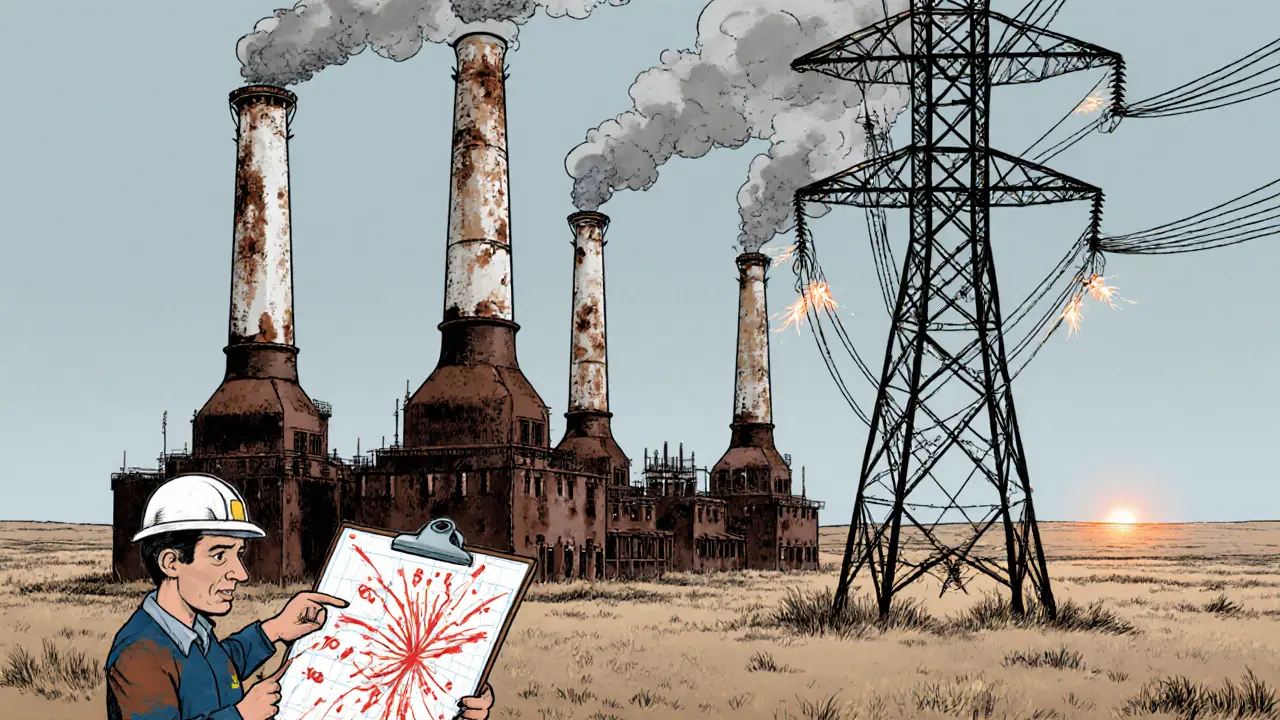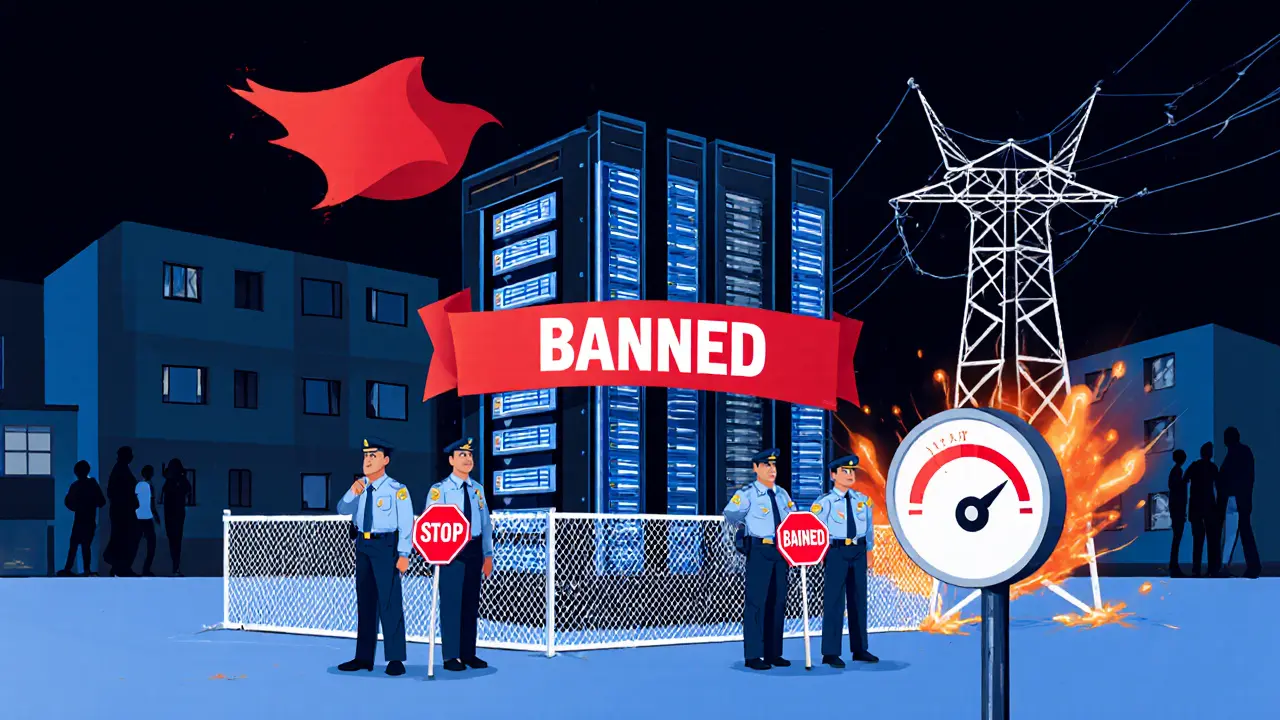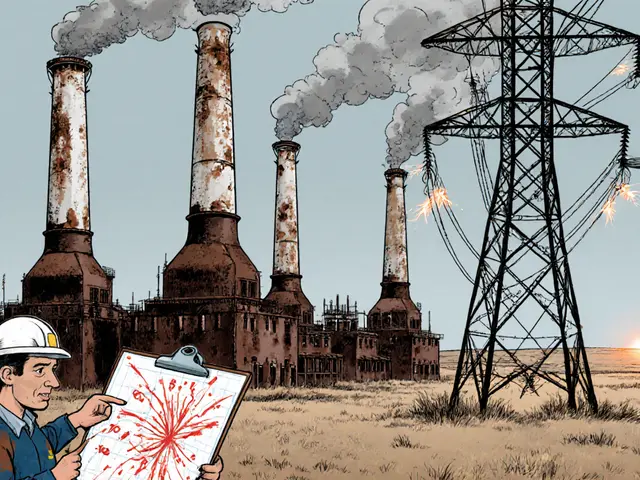Kazakhstan’s Energy Grid Crisis and Crypto Mining Ban Explained

Kazakhstan Grid Loss Impact Calculator
Impact Analysis
ResultsEnter values and click Calculate to see the impact analysis.
Key Insight
As shown in the data, Kazakhstan's national average grid loss rate of 17.42% exceeds the acceptable benchmark of 3-12% in developed economies, indicating a critical situation that affects both industrial and household users.
Key Takeaways
- More than one‑third of Kazakhstan’s power plants are operating at 70‑90% wear, driving massive technical losses.
- Regional transmission losses often exceed 17%, far above the 10‑12% benchmark in developed markets.
- The government has introduced a ban on new crypto‑mining operations to protect an already strained grid.
- Renewables currently supply only 6% of electricity, but three 1‑GW wind farms are slated for completion by 2026.
- Future projects like the North‑South HVDC line and CASA‑1000 interconnection are critical to avoiding shortages by 2030.
Understanding the Kazakhstan a Central Asian nation with vast coal reserves but aging power infrastructure’s Energy Grid
The backbone of the country’s electricity supply is the Unified Power System (UPS) a nationwide network managed by KEGOC that balances generation and demand across 220 power plants. As of January2024, total installed capacity stands at 24,642MW, but only about 20,428MW is reliably available. Kazakhstan energy grid problems stem from two intertwined issues: physical wear on legacy plants and chronic transmission losses.
Scale of Grid Deterioration
Technical wear is staggering-over 33% of facilities report 70‑90% degradation. Regional utilities cite loss rates from a low 3.33% in the most efficient zones up to a crushing 18% in places like Oral. In 2024, the average technical loss across all regions hit 17.42%, meaning roughly one‑fifth of generated kilowatts never reach consumers.
Violations in grid operation surged from 18,600 cases in 2022 to more than 28,000 in 2023 before easing slightly to 18,263 in the first eight months of 2024. The pattern underscores a system under stress rather than a temporary blip.

Impact on Industry and Households
For heavy‑energy users-metal smelters, data centers, and crypto farms-the unreliable grid translates into frequent shutdowns and soaring electricity costs. When a mining rig loses power mid‑hash, the equipment can overheat, leading to costly repairs. For ordinary households, the fallout appears as blackouts during peak winter demand, prompting the government to raise tariffs by roughly 50% in April2025.
The Crypto Mining Landscape and Recent Bans
Crypto mining entered Kazakhstan in 2021, attracted by cheap coal‑derived power and lax regulations. By the end of 2023, estimates suggested the sector consumed 7‑9% of the nation’s electricity-roughly the same share as the entire telecommunications industry.
Faced with grid overloads, the Ministry of Energy announced a blanket ban on new mining installations in early 2025 and ordered existing facilities to either shut down or retrofit with energy‑efficient hardware. Enforcement includes hefty fines and, for repeat offenders, seizure of equipment. The ban does not affect mining operations that have already secured long‑term power purchase agreements and demonstrated compliance with upcoming smart‑grid standards.
Why Grid Issues Triggered the Mining Ban
Energy officials, including Zhakyp Khairushev managing director of the Atameken National Chamber of Entrepreneurs, argue that each megawatt diverted to crypto mining exacerbates regional losses. In Oral, where grid loss already peaked at 18%, the added mining demand risked pushing the zone over a 20% loss threshold, a level that can trigger automatic load‑shedding protocols.
Moreover, the single‑buyer model in Kazakhstan’s electricity market leaves little flexibility for rapid price adjustments, meaning miners cannot simply pay higher rates to alleviate strain. The ban is therefore a pragmatic step to protect essential industrial and residential consumers.

Renewable Energy Push and Future Infrastructure
Renewables-principally wind and solar-account for only 6% of generation but are projected to surpass coal by 2025. The government has committed over $2.6billion to three 1‑GW wind farms and several large‑scale solar parks. However, integrating intermittent renewables requires a more resilient grid.
Key projects under the North‑South HVDC Line a high‑voltage direct current corridor planned for 2024‑2029 to link northern and southern zones will add 2,000MW of transmission capacity and enable better balancing of renewable output. Simultaneously, Kazakhstan is preparing to join the CASA‑1000 a regional power trade project linking Central Asian countries with Afghanistan and Pakistan, providing an export outlet for surplus renewable generation.
Policy Recommendations and What to Watch
The Ministry of Energy the state body responsible for energy policy, regulation, and market oversight has outlined a 2023‑2032 development plan that prioritizes smart‑grid technologies, loss reduction, and accelerated renewable integration. Stakeholders should monitor:
- Implementation of smart‑meter rollouts in high‑loss regions (target: 2026).
- Compliance deadlines for existing crypto miners (final deadline: December2025).
- Progress on the three gigawatt‑scale wind farms (first unit expected online 2024).
- Completion milestones for the North‑South HVDC line (mid‑point 2027).
- Tariff adjustments following the 2025 50% increase-especially for industrial users.
Investors eyeing Kazakhstan’s energy sector should weigh the risk of further regulatory crackdowns against the upside of its burgeoning renewable pipeline.
Quick Comparison: Grid Losses vs Acceptable Benchmarks
| Region | Loss Percentage | Acceptable Range (Developed Economies) | Status |
|---|---|---|---|
| Oral | 13.43% | 3‑12% | Above |
| Western Zone (average) | 17.44% | 3‑12% | Well above |
| National Average | 17.42% | 3‑12% | Critical |
| National‑Level (major cities) | 8.9% | 3‑12% | Within limits |
Frequently Asked Questions
Why did Kazakhstan ban new crypto mining operations?
The ban is a direct response to chronic grid overloads. Mining consumes large, continuous power, and in regions where technical losses already exceed 15%, every new megawatt pushes the system toward automatic load‑shedding, threatening households and critical industry.
How much electricity does crypto mining use in Kazakhstan?
Estimates from 2023 place mining at 7‑9% of national consumption, roughly 1.4‑1.8GW of continuous load, comparable to the entire telecom sector.
What are the main causes of high transmission losses?
Aged infrastructure (many plants operating at 70‑90% wear), inadequate maintenance, outdated conductors, and a lack of modern monitoring equipment all contribute. Regional disparities also reflect uneven investment; some zones have upgraded substations while others still rely on Soviet‑era equipment.
When will the North‑South HVDC line be operational?
Construction runs from 2024 to 2029, with the first 500MW segment slated for commissioning in late 2026. Full 2,000MW capacity should be online by 2029.
How fast is renewable energy growing in Kazakhstan?
Renewable share rose from 4% in 2022 to 6% in 2024. With three 1‑GW wind farms and several solar parks under construction, analysts expect the share to top 20% by 2028 and potentially outpace coal by 2025.
Will existing crypto miners be forced to shut down?
Only non‑compliant operations without long‑term power agreements face shutdown. Miners that adopt energy‑efficient ASICs and join the smart‑grid pilot can continue operating under stricter monitoring.

Darren Belisle
Wow, the grid loss numbers are absolutely staggering!! But hey, there’s always a bright side-maybe this crisis will finally accelerate the shift to truly sustainable energy sources!!!
manika nathaemploy
I totally get why folks are worried, it’s a real pain-definately feels like we’re stuck in a power limbo, but we’ll get through it together. Folks just need a lil’ patience and some smart policies.
Mark Bosky
From a technical perspective, the grid loss percentage in Kazakhstan markedly exceeds the benchmark observed in mature economies. This discrepancy can be attributed to antiquated transmission infrastructure and insufficient demand‑side management. Implementing modern SCADA systems and incentivising renewable generation could mitigate losses substantially.
Caitlin Eliason
It is utterly reprehensible that short‑term profit from crypto mining is jeopardising the wellbeing of an entire nation. The moral imperative is clear: we must prioritize human needs over speculative gains 🙏. Let’s hope regulators act swiftly before more households suffer.
Brian Lisk
When I first looked at the data, the sheer magnitude of the 17.42% loss rate was shocking; it reminded me of the early days of electrification when many systems were still experimental. The loss rate not only dwarfs the 3‑12% range that most developed nations achieve, but it also signifies a massive inefficiency that ripples through both industrial production and everyday life. Each kilowatt‑hour that evaporates in the grid represents a lost opportunity for businesses to compete on a global stage. Families, meanwhile, face higher bills, which erodes disposable income and stifles consumer spending. Moreover, the environmental toll cannot be ignored-extra generation to compensate for losses often relies on fossil fuels, increasing greenhouse gas emissions. In the long run, these compounded costs undermine Kazakhstan’s aspirations for a greener economy. Policy makers could begin by conducting a thorough audit of transmission lines, identifying bottlenecks, and investing in high‑efficiency conductors. Deploying smart‑grid technologies would enable real‑time monitoring and dynamic load balancing, reducing waste. Incentivising distributed generation, especially solar and wind, can also alleviate stress on the central grid. International partnerships may provide financing and technical expertise to modernise infrastructure. Public awareness campaigns can encourage energy‑saving practices, further diminishing unnecessary draw. Ultimately, a coordinated strategy that blends regulatory reform, technological upgrades, and community engagement offers the most viable path forward. It will take concerted effort, but the benefits for the economy, environment, and citizens are undeniable.
Melanie LeBlanc
Hey team, let’s keep the conversation constructive! It’s heartening to see folks rallying around greener solutions-your insights are like bright sparks lighting the way forward.
Don Price
What they don’t tell you is that the mining ban might just be a cover‑up for a larger agenda-perhaps a covert move to shift power control to a shadow consortium. Think about it: sudden policy swings, opaque decision‑making, and the timing aligning with foreign investments in the region. It’s too coincidental to ignore.
Jasmine Kate
Honestly, the drama around this whole grid fiasco feels scripted-like someone’s trying to sell us a horror movie ticket. Let’s cut the theatrics and focus on real data.
Dawn van der Helm
Sending good vibes to everyone dealing with the power cuts! 🌟 Together we’ll find solutions and keep the lights on. 😊
Monafo Janssen
It’s clear that the grid issues affect everyday life, but with community effort and simple steps-like using energy‑efficient bulbs-we can all help ease the burden.
Michael Phillips
In pondering the systemic factors, one might consider the balance between centralized control and distributed autonomy as a philosophical lens through which to view the crisis.
Jason Duke
Ban the miners already!!!
Franceska Willis
i think we should stop the mining, its causing the powrout. thsi is realy important.
EDWARD SAKTI PUTRA
I appreciate the data presented and hope constructive dialogue will lead to sustainable resolutions.
Bryan Alexander
What a roller‑coaster! The grid crisis feels like a high‑stakes drama, but I’m confident we’ll emerge stronger-let’s keep the optimism blazing!
Patrick Gullion
Honestly, banning crypto won’t fix the whole grid; better to invest in infrastructure instead. Just saying.